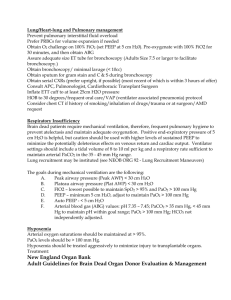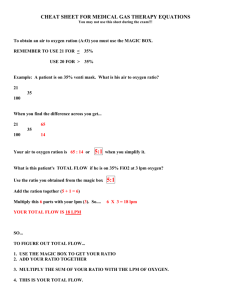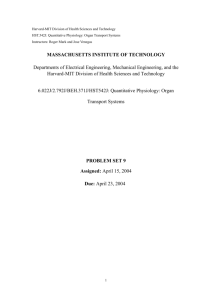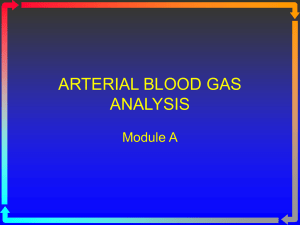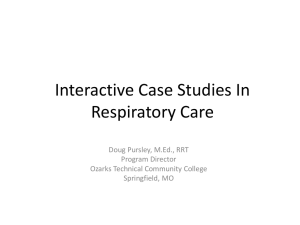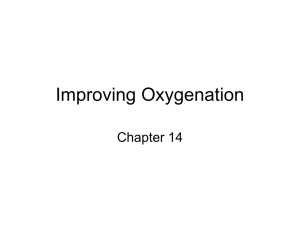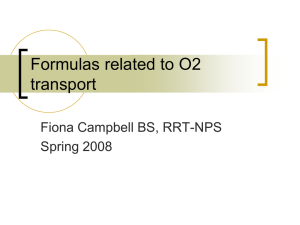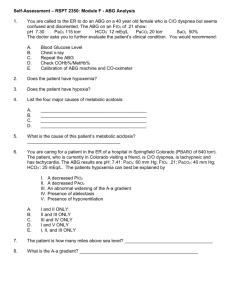Ventilators and ABG*s
advertisement
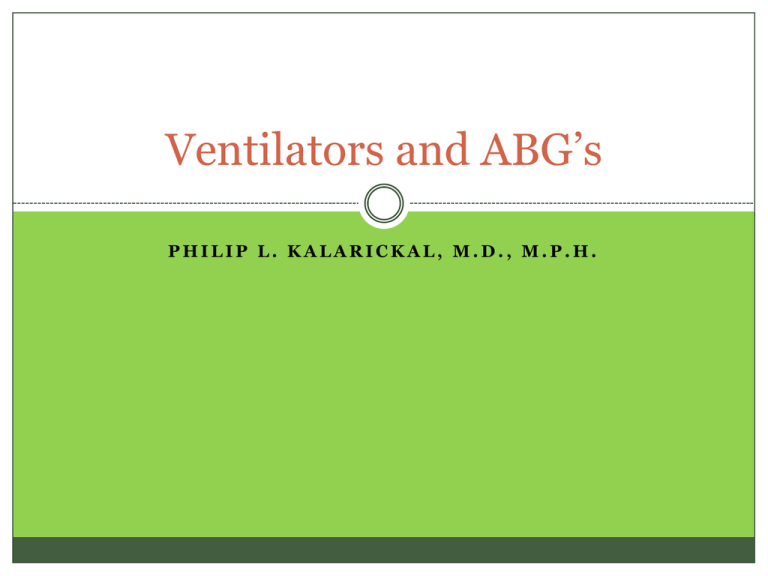
Ventilators and ABG’s PHILIP L. KALARICKAL, M.D., M.P.H. Objectives 1. 2. 3. 4. 5. Review and understand Intubation criteria Understand basic ventilator settings and mechanisms Understand how to monitor a patient on a ventilator A systematic review of ABG analysis Understand the physiology of ventilation and oxygenation. Patient in ER 55 y.o. Male CC: SOB and cough Vitals: Ht: 5’10”, Wt: 70kg T: 38.7 RR: 35 HR: 105 BP: 140/95 Pox: 90% on 100% NRBM What do you do? Intubation Criteria 1. 2. 3. 4. 5. Intubation Criteria 1. Hypoxemia: PaO2 < 60mmHg on >.6 FiO2 2.Hypercarbia: PaCO2 > 60mmHg 3. RR > 30 4. GCS <8 5. Hemodynamic instability - Pressors says, “What vent settings do you want doc?” What settings need to be programmed into the ventilator? 1. 2. 3. 4. 5. The respiratory tech turns to you and says, “What vent settings do you want?” What settings need to be programmed into the ventilator? 1. Mode 2. Tidal volume 3. RR 4. FiO2 5. PEEP Initial Vent Settings Mode: TV: RR: FiO2: PEEP: Initial Vent Settings Mode: 2 basic modes – pressure control & volume control. TV depends on lung compliance. Usually pick SIMV or PRVC TV: 5-7 cc/kg IBW RR: start at 20. Can adjust based off of ABG FiO2: start at 1.0. Can adjust based off of ABG PEEP: start at 5cm H2O Ok, the patient is on the vent. Now what? How do we assess patients on vents? 1. 2. ABG’s 1. 2. 3. 4. 5. 6. ABG’s 1. pH: 7.35 – 7.45 2. PaCO2: 35-45 mmHg 3. PaO2: 80-100 mmHg 4. HCO3-: 22-28 mEq/dL 5.BE: -2 - +2 6. Sat: 97 – 100% You get your first gas…. 7.30/55/200/24/0/100 What do you think? What do you want to do? 1. Acid/Base 2. Ventilation 3. Oxygentation Acid/Base 1. Look at pH to determine primary process 2. Then look at PaCO2 and HCO3- to determine relative contribution of Respiratory and Metabolic components to acid/base disturbance and the degree of compenation. Ventilation Measured by PaCO2 ***Oxygentation and Ventilation are independent processes*** Ventilation is a function of MV MV= TV x RR Usually by RR rather than TV This patient has an elevated PaCO2. He is hypoventilating (retaining CO2). We should increase RR Ventilation You ask the Resp Tech to increase RR to 24 and check an ABG in an hour The repeat gas is: 7.40/40/200/24/0/100 Now what? Have we addressed oxygenation yet? What do you think about the PaO2 of 200mmHg? Oxygenation How do we assess oxygenation? 1. 2. What is PaO2? What does PaO2 mean? It is the pressure of oxygen that is dissolved in plasma It contributes very little to oxygen delivery CaO2 = 1.34 x Hb x sat + .003(PaO2) Helps assess how well oxygen exchange occurs at the alveolus You need to compare it to PAO2. P AO 2 PAO2 = [(Patm – PH2O)FiO2] – (PaCO2/0.8) Because oxygen and carbon dioxide are small molecules, there should be almost perfect gas exchange across the alvelous to pulm capp. P AO 2 Example: on 100% oxygen, PAO2 = [(760-47)x 1] – (40/0.8) = 710 – 50 = 650mmHg Rule of Thumb: PaO2 should be about 5x O2% Ex: on 100% O2, PaO2 should be approx 500mmHg Now what do you think about the PaO2 of 200 mmHg on our ABG? If we have an unexpected result, we should correlate it clinically. Why would this patient have problems with oxygen exchange across the alveolus? In other patients, different causes may be higher on the differential CHF exacerbation and pulm edema Pneumothorax Mucous plug ETT in main stem bronchus Etc… Ok, we know we have a problem with oxygenation, now what? How do we improve oxygenation? 2 ways: Increase FiO2 Increase PEEP Are there any drawbacks to PEEP? Yes Barotrauma Inhibits venous return Effect of Increased PEEP- example •“Best” PEEP – the level of PEEP at which you improve oxygenation the most without significant effects on venous return PEEP (cm H2O ) Sat PaO2 BP 5 100 200 135/90 7 100 250 130/80 9 100 350 115/70 11 100 450 85/55 In this example, 9cm H2O is the “Best” PEEP Oxygenation Ok, we’ve improved oxygenation via PEEP and hope to improve it further with anitbiotics for his pneumonia. Now what? Are we happy with his FiO2? Are there problems with high FiO2? 1. 2. Oxygenation You should wean FiO2 to minimum to maintain sats > 95% (PaO2 > 80) Why? Oxygenation Problems with high FiO2 “oxygen toxicity” – due to oxygen free radicals that may cause alveolar damage Risk factor – FiO2 > .6 for greater than 24 hours High FiO2 is not safe for patients Saturation is a relatively insensitive measure of oxygenation (sats won’t drop until PaO2 is less than 80-100) Low FiO2 allows you to know your PaO2 within a narrow range without drawing an ABG. 1. Ex: Pt. on 100% O2 with sats 100% The lowest PaO2 can be is 80 mmHg The highest PaO2 can be is 500-600mmHg Pt on 30% O2 with sats 100% The lowest PaO2 can be is 80 mmHg The highest PaO2 can be is 150 mmHg 2. Low FiO2 will allow you to identify problems earlier A patient on 30% O2 will desat sooner than a patient on 100% O2 In other words, 100% O2 will “mask” a problem 3. If a patient is on a low FiO2 you can increase to 100% to buy time to make a diagnosis and treat. Now you know almost everything you need to know about Vents and ABG’s Intubation Criteria 2. Basic ventilator settings 3. Assessing patients on vents 1. 1. 2. Pulse oximeter ABG’s 4. Analyzing ABG’s 1. Acid/Base 2. Ventilation 3. Oxygenation
